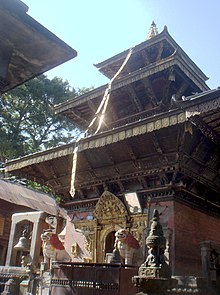 Bajrayogini Temple could be a Buddhism temple placed at Sankhu in Nepal's Katmandu vale. it's additionally renowned as Bodhisattva's Temple. The temple is truly a form of temple advanced, with the most temple having been engineered by King Pratap Malla within the sixteenth century. Bajrayogini is that the Hindu deity of knowledge of that Ugra town is that the Buddhist equivalentThe Bajrayogini Temple is settled roughly twenty kilometres northeast of Katmandu. the realm wherever it's placed is usually remarked as Gunbaha, which might be roughly translated from Newari as ‘recreational forest place’. the most temple could be a three-story high building, that was clearly fastidiously created with the utmost attention to detail. you may doubtless realize a sculpture of the deity Bajrayogini during this temple which can feature a red face with 3 eyes further as hands, that have the thumb and finger fastidiously, decorated. Ornaments surround her sculpture.
Bajrayogini Temple could be a Buddhism temple placed at Sankhu in Nepal's Katmandu vale. it's additionally renowned as Bodhisattva's Temple. The temple is truly a form of temple advanced, with the most temple having been engineered by King Pratap Malla within the sixteenth century. Bajrayogini is that the Hindu deity of knowledge of that Ugra town is that the Buddhist equivalentThe Bajrayogini Temple is settled roughly twenty kilometres northeast of Katmandu. the realm wherever it's placed is usually remarked as Gunbaha, which might be roughly translated from Newari as ‘recreational forest place’. the most temple could be a three-story high building, that was clearly fastidiously created with the utmost attention to detail. you may doubtless realize a sculpture of the deity Bajrayogini during this temple which can feature a red face with 3 eyes further as hands, that have the thumb and finger fastidiously, decorated. Ornaments surround her sculpture.According to a holy book, that was once discovered previously, the location of the temple was once a forked piece of stone, that spouted fireplace. This was quite vital once the remainder of the planet was lined with snow and shortly there emerged a five-colored flame, that came to be the volcanic deity. The deity ordered that a temple be engineered on the sight of her emergence and monks are creating use of the 9 encompassing caves for hundreds of years to serve this temple ever since. the primary priest to serve here was purportedly given superior enlightenment and Bajrayogini is taken into account to be one in all the wisest and strongest gods able to grant this gift. there's a fine looking spigot complete with ornamental sculpture within the space, that dates back to the fourth century.The attraction here isn't solely the assorted temples however additionally the various alternative attention-grabbing temples and caves that encompassing it – a number of that area unit thought-about to be older than the temple itself.

Amongst the caves within the space could be a graven double chamber with window attributed to being employed by Marpa Lotsawa. Whereas close could be a little chamber engineered into alittle formation that was wherever Milarepa was walled certain solitary retreat.
The hill prime is accessed by a awfully long graven stone stairs. the whole website is roofed richly with Newari subject area metal work, graven wood details, and ancient artifacts. together with alittle stupa claimed to pre-date Buddha Shakyamuni.The earthquake that affected on twenty five Apr 2015 had huge result on Sankhu town. Bajrayogini temple was no exception. The statues of Bajryogini temple area unit safely shifted and also the temple is supported with wood planks .